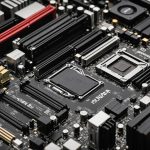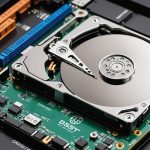Understanding Chipset Compatibility
When selecting a motherboard, understanding different chipset compatibility is crucial. Motherboard chipsets serve as the communication center and data traffic controller, determining support for components like the CPU and RAM. Each chipset type offers distinct capabilities, ranging from integrated graphics to enhanced overclocking features.
Ensuring a compatible motherboard with your CPU guarantees maximum efficiency and prevents bottlenecking. There’s a plethora of motherboard chipsets designed for various needs. For instance, Intel’s Z and H series offer excellent performance for high-end builds, with the Z series being a preferred choice for enthusiasts due to its comprehensive overclocking support. AMD’s X and B series provide similar benefits for their processors, with X series chipsets being renowned for robust feature sets.
This might interest you : Top tips to boost pc case airflow for optimal cooling efficiency
Incompatible chipsets can lead to hardware malfunctions or performance drops, making it essential to research thoroughly before purchasing. Opting for a popular chipset ensures future-proofing and access to the latest advancements in technology. Explore models with rich features tailored to your build’s requirements, allowing expansion and enhancements over time.
Understanding these factors can significantly improve your decisions when choosing or upgrading a compatible motherboard to elevate your system’s performance.
Also read : Unleashing speed: discover the advantages of installing your operating system on a solid-state drive
Form Factor Considerations
Understanding the motherboard form factor is essential when building or upgrading a system. Form factors, such as ATX, MicroATX, and Mini-ITX, determine the board’s size and shape, influencing the overall build size and component placement.
-
ATX: Known for its full-size dimensions, the ATX format accommodates numerous expansion slots and ample connectivity options. It’s ideal for high-end builds demanding robust capability.
-
MicroATX: Slightly smaller, this form factor offers a balance between performance and size. It’s perfect for users needing moderate expandability without sacrificing too much space.
-
Mini-ITX: The smallest of the three, this is best for compact builds where space is limited. While it offers fewer expansion slots, it remains a popular choice for minimalist designs.
The form factor directly affects component selection by dictating compatibility with cases. For instance, a Mini-ITX motherboard requires a compatible case designed to fit its dimensions. Selecting the right form factor can impact your system’s cooling efficiency and cabling management. Consider your priorities, such as the number of PCIe slots, storage drives, and cooling solutions, before finalizing your decision. It’s crucial to ensure the motherboard form factor aligns with your build size and hardware compatibility requirements.
RAM Support and Overclocking
Understanding RAM compatibility is vital when assembling or upgrading a PC. Your motherboard’s compatibility with various RAM types and speeds directly impacts system performance. Check the supported RAM types (e.g., DDR4, DDR5) and maximum memory frequency to prevent potential mismatches.
The number of memory slots on a motherboard determines the total memory capacity your system can handle. More slots typically mean greater maximum memory support, allowing for future upgrades to enhance performance without replacing existing modules.
Overclocking support is another key factor. Overclocking increases the performance of RAM, enhancing data processing and multitasking capabilities. This is especially useful for users seeking to push their systems beyond standard specifications. However, not all motherboards support extensive overclocking, so selecting a model that aligns with your performance goals is crucial.
Considerations such as heat dissipation and power stability should also be evaluated. Overclocking without adequate cooling can cause instability or damage components. Motherboards with specific overclocking features and design optimizations are better suited to manage these risks, ensuring consistent and reliable performance during demanding tasks. As ever, understanding your needs and the options available will guide you towards the most suitable choice for your build.
Connectivity Options
When investing in a new motherboard, connectivity options are a critical factor to consider. Access to diverse ports ensures smooth integration of peripherals and efficient data transfer. Key components include USB connectivity, which often features USB 3.2 for high-speed data transfer and multipurpose USB-C ports. These ports adapt to various devices, ensuring compatibility with your tech arsenal.
Moreover, reliable network connection options like Ethernet and integrated Wi-Fi cards are paramount for maintaining stable internet access. Selecting a motherboard with HDMI support facilitates seamless connection to monitors and TVs, crucial for both work and entertainment setups.
PCIe slots play a significant role in expansion and upgradability. They allow for the addition of graphics cards, sound cards, or SSDs, maximising future proofing. A well-equipped system anticipates tech advancements without needing a complete overhaul. Consider motherboards that provide ample PCIe slots to support your evolving needs.
For high-end builds, opt for motherboards with a generous assortment of ports and slots to maintain flexibility and enhance performance. This choice not only streamlines connectivity but also paves the way for future upgrades, ensuring that your system remains adaptable as technology progresses.
Power Delivery Systems
An efficient power delivery system is critical for ensuring stable performance, especially during demanding tasks. The Voltage Regulator Module (VRM) quality is a pivotal component in managing power flow to the CPU and other components. A high-quality VRM is essential for maintaining performance and preventing overheating or instability.
When selecting a motherboard, consider the power connectors it supports. The number and type of power connectors can influence power distribution efficiency and overall system stability. Some motherboards offer additional 8-pin power connectors to facilitate better power delivery to the CPU, which is beneficial for high-performance systems and overclocking.
For those seeking stability during intense operations, evaluating the motherboard’s power delivery capabilities is paramount. Look for models equipped with robust VRMs and adequate cooling solutions. This ensures that the motherboard can handle the thermal and electrical demands of modern processors.
In summary, a motherboard with a reliable power delivery system and quality components will support heavy workloads and extend the hardware’s lifespan. Prioritising these features can significantly enhance the performance and reliability of your build, providing a foundation for future upgrades and tech advancements.
Expansion Slots and Upgrade Potential
Expansion slots play a vital role in defining a motherboard’s upgrade capability. They accommodate various components, such as graphics cards, SSDs, and network cards, amplifying the motherboard’s functionality beyond its initial configuration.
PCIe slots are fundamental for high-performance graphics and additional storage, while M.2 slots cater to fast, compact storage solutions. Understanding the type and number of expansion slots is crucial for evaluating future upgrade potential. A motherboard with ample expansion options offers flexibility, allowing users to adapt their systems to new technologies and demands.
In assessing a motherboard’s future-proofing abilities, consider models that offer robust expansion capabilities. This ensures adaptability as new hardware becomes available, preventing obsolescence and safeguarding your investment. Brands often highlight these features, making it easier for potential buyers to identify models that meet their long-term requirements.
Focus on expert recommendations to guide your choice. Experienced reviews and expert insights provide valuable perspectives on which motherboards excel at offering versatile expansion options. This inside knowledge aids in making a grounded decision that aligns with both current and future needs. By selecting thoughtfully, you pave the way for endless possibilities in system enhancements.
Comparative Analysis of Popular Motherboards
Exploring the landscape of motherboard comparison for high-end builds demands a nuanced understanding of key differences among available models. This section delves into analysing the best high-end motherboards, highlighting distinct features to aid in selection.
Key Features of Top Models
Several top-tier motherboards stand out owing to their feature comparison. Models boasting comprehensive connectivity options, robust power delivery, and extensive expansion slots offer desirable traits. For instance, the inclusion of advanced M.2 slots and next-gen PCIe lanes significantly enhances upgrade capability.
Performance Metrics
An effective performance analysis reveals variances in how these motherboards manage multitasking, cooling efficiency, and power distribution. High-end models often outperform in areas like VRM quality, critical for overclocking and maintaining stability under demanding workloads.
Price vs Performance Analysis
Conducting a price vs performance analysis helps identify where investment in a premium motherboard pays off in long-term system reliability and feature richness. The balance between cost and upgrade potential, alongside support for future technologies, ultimately defines true value. Discovering the sweet spot in price and performance offers assurance, not just for today, but for future advancements.
Expert Recommendations and Tips
When choosing a new motherboard, leveraging expert recommendations and valuable buying tips can significantly streamline your decision-making process. Let’s unpack what the experts suggest for buying tips and how motherboard reviews could be your guiding star.
Expert recommendations often highlight the top-performing models in varied categories. These insights are invaluable for identifying motherboards that excel in power delivery, connectivity, and expansion slots. Experts often emphasise motherboards with robust VRM quality for stable performance, even in demanding scenarios.
Look for practical buying tips focusing on compatibility, such as ensuring the chipset aligns with your CPU for seamless integration. Additionally, prioritising motherboards with numerous expansion slots can future-proof your setup, allowing adaptability with tech advancements.
Motherboard reviews offer a wealth of information, with detailed analyses of performance metrics and user experiences. These reviews can guide your choices by providing real-life insights into motherboard capabilities.
Ultimately, tapping into expert recommendations and utilising practical buying tips helps you navigate the complex landscape of motherboards. This informed approach ensures you make decisions aligned with both current performance needs and future expansion goals.
Ensuring Longevity and Future-Proofing
Choosing a motherboard that supports future-proofing not only enhances your system’s longevity but also ensures it can accommodate emerging tech advancements. Future-proofing involves selecting a model with ample expansion slots, such as PCIe and M.2, allowing you to incorporate new components without needing a full replacement. For best upgrade capability, look for motherboards with multiple USB ports and upgraded HDMI interfaces to support upcoming peripherals and display technologies.
When considering key features, chipset compatibility plays an essential role. A motherboard that harmonises well with cutting-edge CPUs and RAM compatibility standards, like DDR5, offers performance longevity. Ensuring the motherboard supports overclocking can further boost its utility by enabling efficient utilisation of resources under demanding tasks.
To maintain long-term reliability, prioritise models with quality VRMs and cooling solutions, as these enhance stability during intensive workloads. Consistent cooling mitigates overheating risks, prolonging component life.
By making informed choices, you’ll secure a system that adapts to evolving tech landscapes, providing robust performance over time. Flexibility in upgrading and expansion is paramount in preparing your technology to face future challenges and opportunities.











